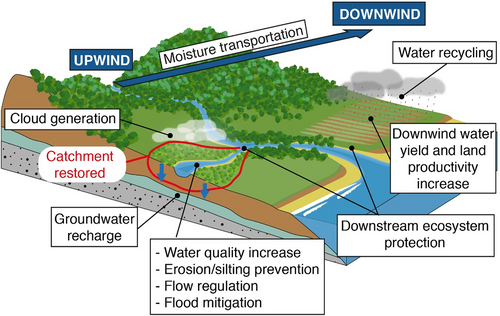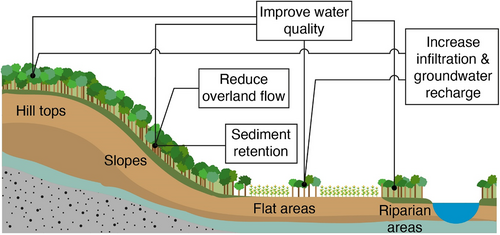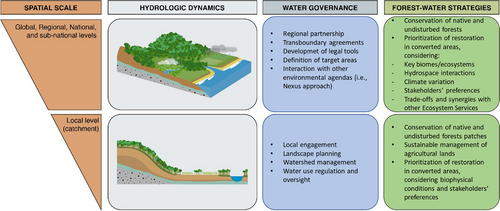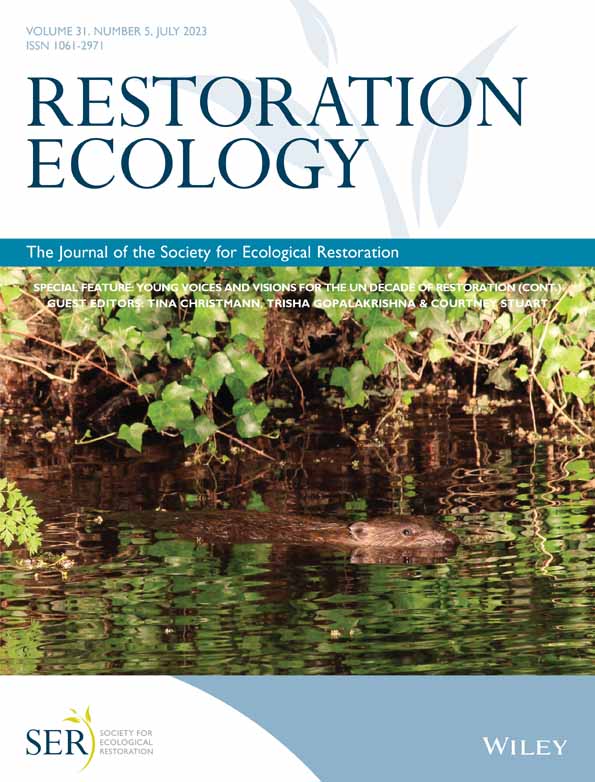Shedding light on the complex relationship between forest restoration and water services
Author contributions: VD, PB, SCC, MC, DE, VF, SF, PM, AP, DR, AI, AV, BS conceived and designed the research; VD wrote the original draft; all authors reviewed and edited the manuscript.
Abstract
Although native vegetation is a determinant of aquatic ecosystems' maintenance, forest restoration has been linked to decreases in water yields worldwide. Here, we clarify linkages between forest restoration and water services and identify gaps in the literature critical for evaluating the benefits of forest restoration on water yields. Also, we discuss possible strategies to improve forest restoration planning and implementation. We argue that the apparent disconnect between estimates in the literature and real-world observation reflects the limitation of studies, methods, and approaches in capturing forest and water relationships' complex nature. Future research should focus on hydrologic parameters other than annual streamflow flow (such as infiltration, groundwater recharge, and flow regulation) and encompass broader spatial–temporal scales. More empirical studies are needed, especially in the tropics, as the forest–water dynamics in these areas are unique and poorly understood. Filling this gap is critical to improving the decision-making process related to water management and governance.
Implications for Practice
- A better understanding of forest restoration impacts on water services (including flow regulation, groundwater recharge, precipitation recycling, and water quality) is paramount to defining target areas to be restored around the globe.
- The impacts of forest restoration on water vary with time and depend on where and how restoration interventions are implemented. To design the best restoration strategy, we must consider who benefits from or might be impacted negatively by unintended consequences on water services.
- Scaling up ecosystem restoration actions is the challenge posed to the world by The UN Decade on Restoration (2021–2030). We believe that the hydrological dimensions can provide an excellent argument to scale restoration by stimulating partnerships at regional and global scales while considering local beneficiaries.
Introduction
Several water-related ecosystem services are derived from forest functions, such as groundwater recharge, buffering and filtering of pollutants, regulation of rainfall and seasonal flows, and the provision of habitats and scenic landscapes (UNECE 2018). To sustain these functions, forest restoration has emerged as a preferred tool to recover water services when native forests are disturbed or converted to anthropogenic land uses (Chazdon et al. 2017). Controversially, forest restoration has been linked to decreases in annual water yields worldwide (Filoso et al. 2017; Zhang et al. 2017). This apparent dubious relationship may limit the adoption of forest restoration actions in this context (Ellison 2018). Here, we dive into the forest–water nexus's complex nature to explore its linkages and discuss how forest restoration interacts with the provision of water-related services. We also explore the response of often omitted parameters of hydrologic processes (such as groundwater recharge and flow regulation) and consider the broader spatial–temporal scales to evaluate the potential benefits of forest restoration on watershed functions and attributes.
The Forest–Water Nexus
Forests and water are interconnected in a socioecological system, the “forest–water nexus” (Springgay et al. 2019). At catchment scales, restored forests are known to affect key hydrologic processes that lead to positive effects on ecosystem resilience and help to support desired ecosystem services, such as the regulation of water flows and water quality (Neary et al. 2009; de Mello et al. 2020). Forested and well-managed catchments also protect local and downstream aquatic ecosystems and people relying on them, preserving livelihoods and cultural diversity. At the regional and continental scales, forests contribute to atmospheric water recycling, including cloud generation, precipitation, and moisture transportation (Sheil 2018). From the Hydrospace perspective, that considers sources and sinks of air moisture, moisture transportation from upwind restored areas might increase water yields and land productivity in downwind basins (Ellison 2018; Fig. 1). Conversely, forests can reduce local water yield as trees intercept, consume, and transfer water to the atmosphere. These latter processes form the groundwork of most studies that link forest restoration to declining water availability.

The prevailing understanding that forest restoration diminishes water yields is largely based on information from studies available to date, which have a series of limitations in terms of design and methods (Filoso et al. 2017). Most empirical studies are typically conducted at relatively small spatial and temporal scales. Studies that focused on longer temporal scales (e.g. >50 years) and larger spatial scales (e.g. >1,000 km2) adopt modeling approaches (Filoso et al. 2017; Zhang et al. 2017), often limited in capturing the complexity of the water cycle (Ellison et al. 2019). Also, most studies are based on afforestation of nonnative species, and focus only on changes in water yields (usually annual streamflow). To review this paradigm of the negative impact of forest restoration on water production, we need to understand how forest restoration affects the water cycle in the long term and beyond the catchment scale, especially the feedback processes that control precipitation recycling.
A Matter of Time and Space?
In a few years after restoration, vegetation can retain nutrients and sediments, reducing soil erosion, siltation of water bodies, and improving downstream water quality (Gageler et al. 2014). In long temporal scales, restored forests improve soil attributes such as moisture, water storage, and infiltration due to the litter layer, the accumulation of large organic debris, root system, and soil biodiversity recovery (Ilstedt et al. 2007). Improving soil attributes depends on the degradation level and historical land-use transitions and might take years or decades to occur (Lozano-Baez et al. 2019). The gain in infiltration rates can result in groundwater recharge improvement depending on climate and geophysical parameters, such as precipitation patterns, relief settings, slope, and soil type (Moeck et al. 2020). Late successional forests can act as “sponges” (due to their extensive root systems and moisture-retaining leaf litter), providing seasonal flows regulation (reducing peak flows and increasing baseflows) and overland flow reduction (Peña-Arancibia et al. 2019). In general, seasonal flows and groundwater recharge variation depend on the net effect of changes in infiltration and evapotranspiration (ET; Bruijnzeel 2004). However, differences in infiltration rather than ET drive the groundwater recharge and seasonal flows in the humid tropics (Krishnaswamy et al. 2013).
Evapotranspiration is the combination of plant transpiration and soil evaporation. Early successional restored forests exhibit higher ET profiles due to pioneer plant physiology (they usually grow faster and consume more water) and elevated evaporative rates (Giambelluca 2002). Water use tends to reduce and stabilize during the late successional stage resulting in ET reduction. For instance, an empirical study showed that ET and gross primary productivity are higher in secondary than in native forest in the Amazon (Von Randow et al. 2020). It suggests that initial drops in water yield gradually recover over time. However, strong evidence for this hypothesis is still needed. A recent study showed that the ET rates can be higher in late successional forests than in secondary forests (Meerveld et al. 2020)—although authors recognize their late successional forest plots had relatively many young trees. A meta-analysis conducted by Bentley and Coomes (2020) showed that in most catchments studied, the declines in annual streamflow after forest restoration persisted after decades. Catchments from tropical regions were underrepresented in this study.
On the one hand, we still lack evidence showing streamflow recovery after restored forest reaching late successional stages. On the other hand, it is known that deforestation increases annual water yields, primarily due to the decrease in ET rates (Zhang et al. 2017). However, part of the water produced in a short period during the rainy season does not infiltrate to feed water tables or subsurface flows (Marques et al. 2022). This excess of water flows overland and remains unavailable for human use, increasing flooding risks, soil erosion, and water bodies siltation (Bradshaw et al. 2007; Gharibreza et al. 2020). Whether water yields reduction is a service or a disservice is context-dependent. In this sense, the observation of flow regulation and groundwater recharge can be more helpful to understand the real effects of forest restoration on water availability in the long run than focusing on the annual streamflow.
At larger spatial scales, precipitation recycling occurs both within and beyond the catchment boundaries (Wang-erlandsson et al. 2018). Forests act as “pumps” increasing air moisture and rain downwind (Peña-Arancibia et al. 2019). Depending on the size and location of the reforestation area, climate conditions and land-use and cover of downwind catchments, annual water yield can also increase. A better understanding of the Hydrospace, that is, considering both upstream and downstream and upwind and downwind interactions, is critical to guide decision-makers in addressing forest restoration-related phenomena beyond the basin. Coupled land-surface-atmosphere models can assess feedback processes that control precipitation recycling (Pilotto et al. 2017). Such a modeling approach—integrated to ground level and remote sensing earth observations—could improve our ability to define atmospheric moisture flux sources and sinks (Ramos et al. 2019).
How about the Tropics?
Tropical forests present high ET rates and are responsible for climate regulation on regional and continental scales (Ramos et al. 2019). They are arguably among the most important areas for proving the relationship between forests and water supply, but are underrepresented in the literature (Filoso et al. 2017; Bentley & Coomes 2020). Filling this gap is critical as hydrometeorological processes in the humid tropics differ from other regions. They usually present greater energy inputs (such as moisture fluxes from the mid latitudes and intense precipitation) and high rates of weathering, creating large volumes of water and sediment transport. Atmospheric moisture cycling also differs from other regions by its warmer and uniform temperatures and the pronounced spatial gradients of precipitation (Wohl et al. 2012). The major impact of deforestation on the water cycle in these areas is the reduction of the local ET, thus reducing the total amount of moisture available for precipitation recycling (Bruijnzeel 2004).
Forest cover loss in the tropics has been rising steadily over the past decades and these areas hold great global restoration opportunities (Brancalion et al. 2019; Strassburg et al. 2020). Many projects of forest restoration have been proposed over the next decades to meet national and global commitments, such as the Bonn Challenge and the UNFCCC Paris Agreement, reinforced by the ongoing UN Decade on Ecosystem Restoration (Sewell et al. 2020). Less developed countries—which also fight severe water security problems—are the ones pledging the highest amount of area for restoration (Fagan et al. 2020). The implementation of these projects can be an opportunity to developing a better understanding on the forest–water relationship, but also must be conducted based on the knowledge science can provide so far. Identifying the Hydrospace around the main tropical forests, the impacts of large-scale restoration scenarios on precipitation recycling, the potential of water quality delivery, and the potential of groundwater recharge are critical to determining the priority areas to be restored in the globe.
Lessons for Water Governance
Knowledge production and water governance are cross-cutting research agendas relevant to tackle problems of water crisis from local to global levels (Mdee et al. 2022). Where conservation efforts are not enough, the spatial planning of forest restoration and the identification of priority areas to be restored is crucial to optimize benefits and minimize costs and unintended consequences (e.g. local water yield declines in the early years following restoration). Forest restoration outcomes for water services depend significantly on how and where restoration interventions are implemented. Restoration strategies can vary greatly in their impacts on hydrologic processes. Also, landscape variation on elevation, slope, soil type, and water table depth significantly impacts hydrologic processes (Sheil 2018; Fig. 2).

Forest cover may compete with other land uses that provide more immediate economic returns. Considering who benefits from water services or might be impacted by unintended consequences is fundamental to design the best restoration strategy (Palmer & Filoso 2009). Conflicts of interests can emerge when restoration targets are outside of the beneficiaries' location boundaries. Because most decision-making about water traditionally derives from catchment dynamics, the tendency is to emphasize the needs of the catchment and ignore the regional community's needs. In this sense, downwind/downstream communities are likely to be disadvantaged.
From a regional/global perspective, atmospheric teleconnection dynamics must be considered (Keys et al. 2017). Regional partnerships and transboundary agreements are critical to developing and enforcing legal tools and defining target areas for forest conservation and restoration (Melo et al. 2020). The big challenge is to define strategies to adequately integrate regional-scale hydrologic concerns into the modeling and political decision-making framework. Recommendations on water governance and forest–water management strategies are summarized in Figure 3.

Finally, we suggest a research agenda focused on disclosing the spatial–temporal scale dependence of the restoration impacts on water. It should include long-term and large-scale empirical studies, especially in the tropics, considering effects of restoration on ET, water infiltration, groundwater recharge, and flow regulation. Unsolved questions should be addressed, such as: (1) How long do catchments take to return to predisturbance water yields and seasonal flows after forest restoration? (ii) Does this change with catchment size and previous land use? and (iii) How and at what scale is the atmospheric moisture produced by forests reintegrated into the terrestrial hydrologic processes?
Acknowledgments
Financial support was provided by the International Climate Initiative and the Brazilian Platform on Biodiversity and Ecosystems Services. VD is grateful to CNPq and CAPES for scholarships.




